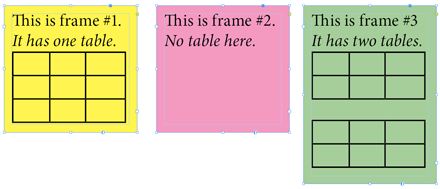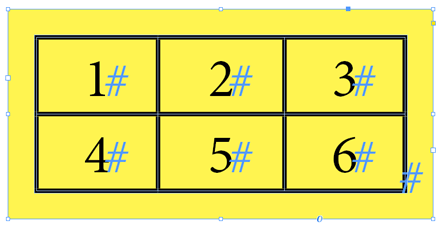Understanding the `count( )` Method
November 13, 2020 | Tips | en
InDesign's scripting infrastructure is based on DOM objects (Document, Story, Paragraph…) and any such object has an associated collection (Documents, Stories, Paragraphs…). Collections typically arise in complex specifiers like myDocument.stories.everyItem().words. They also provide two essential members, the length property and the count() method. How do they differ?
Suppose your active document, doc, has three text frames. Then the doc.textFrames collection has exactly three elements and, of course,
doc.textFrames.length == doc.textFrames.count() // == 3
But it is misleading to put length and count() on an equal footing. In fact, these are not the same commands at all.
Length
Let K denote any formal collection, that is, any DOM path that ends up in a collection property like .stories, .words, .tables, etc. For example, K=doc.textFrames.everyItem().tables is a formal collection which represents the tables of all text frames. The scripting subsystem treats K as a single Tables object and lets it enjoy all properties and methods of any collection. In particular, you can apply the .everyItem() operator to K and get a plural Table specifier, which lets you enter in sub-collections like .cells, .pageItems, and so on.
But here is the point: no matter how complex your formal collection is, K.length always returns a single integer, representing the overall number of elements available in that collection.

Thus, if your document still has three frames which respectively contain one, zero, and two tables as illustrated above, then K.length (that is, doc.textFrames.everyItem().tables.length) will return the total number of available tables (3 = 1+0+2).
K.length is therefore a flat command that merges all individual results. It is strictly equivalent to a much longer, and much less efficient syntax: K.everyItem().getElements().length (!!)
Count
Unlike K.length, K.count() considers separately the concrete collection(s) involved in K (in our example, frame1.tables, frame2.tables, frame3.tables). The command then gets the number of elements available in each collection and outputs an array of integers (instead of the overall sum), provided that several objects are visited:
K = doc.textFrames.everyItem().tables; // An array of three numbers is returned // because there are three text frames. // --- alert( K.count() ); // => 1,0,2
Although poorly understood, the count() method is very powerful. In a way it allows a formal collection—which is not itself a plural specifier—to temporarily behave as a plural entity for counting purpose. Remember how the doc.textFrames.everyItem().id syntax works: it generates an array of IDs. But doc.textFrames.everyItem().tables is not an array of Tables, it's just a single, formal Tables collection. Thanks to .count(), we get access to the table count of each text frame upstream the .tables selector.
In other words,
doc.textFrames.everyItem().tables.count()
works as if the TextFrame object had a tablesCount property. It then returns:
doc.textFrames.everyItem().tablesCount
which is an array of tablesCount values.
Note. — If a single entity is selected upstream, then K.count() returns a single value and K.length==K.count(). A stable property is is that K.length represents the sum of the values returned in K.count().
Exercise

Given a Table myTable formed of 6 cells, we notice that:
• myTable.cells.everyItem().texts.count()
returns an array of six 1's: [1,1,1,1,1,1]
while
• myTable.cells.itemByRange(0,-1).texts.count()
simply returns 6 (unique number.)
What does this tell us about cells.itemByRange(0,-1) vs. cells.everyItem()?
• See also:
— “On everyItem() – Part 1”;
— “On everyItem() – Part 2”.
